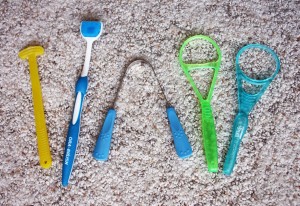
A tongue scraper is a tool used to help clean your tongue. Tongue scrapers come in a variety
of shapes and sizes, and work by starting at the back of the tongue and pulling the scraper
forward. Some people choose to clean their tongue by using their toothbrush as well.
Some say that cleaning your tongue helps keep your breath fresh, but there is no evidence that
brushing or scraping your tongue will prevent bad breath or improve halitosis (chronic bad
breath). In fact, bad breath bacteria can grow back just as fast as you remove it.
If you like the way your mouth feels after you clean your tongue, keep it up as part of your daily
dental routine. It can be a great way to go the extra mile for your mouth, but comes down to personal preference and is not a necessary step.
However, there are four things you can do to make sure your mouth is healthy:
1. Brush your teeth twice a day with a fluoride toothpaste.
2. Clean between your teeth daily.
3. Eat a healthy diet that limits sugary beverages and snacks.
4. See your dentist regularly for prevention and treatment of dental disease.
How to perform a tongue scraping to perform tongue scraping, you’ll need the right tool — a tongue scraper. A quick search for
tongue scrapers can reveal lots of options. These include ones made from plastic, copper, and
stainless steel.
Most will have a slightly rounded shape, much like an inverted spoon. If you’re in a pinch,
household items like a spoon (clean, of course) or your toothbrush will do. However, they may
not remove as much odor-causing bacteria as a dedicated tongue scraper.
To perform tongue scraping, follow these steps:
1. Stand in front of a mirror, open your mouth, and stick out your tongue.
2. Gently set the rounded end of the tongue scraper at the back of your tongue.
3. If you’re worried about gagging, you may find it helpful to start at the middle of your tongue.
You can gradually start from farther back as you get used to scraping.
4. Gently touch the scraper to your tongue. Slowly pull it forward, toward the tip of your tongue.
You should never push the scraper from the tip of your tongue back. Always go from the back of
the tongue to the tip.
5. After each scrape, use a washcloth or tissue to remove debris from the scraper.
6. Repeat until you’ve scraped the entire surface of your tongue. One to two scrapes across the
same area is usually enough.
7. Wash the tongue scraper with warm water and soap, dry, and store in a clean, dry area.
The entire process usually takes less than two minutes. Repeat as needed throughout the day.
Are there any side effects or risks to consider?
One of the biggest concerns about tongue scraping is stimulating the gag reflex. This could
make you vomit while tongue scraping.
To avoid this, refrain from placing the scraper too far back on your tongue. When you first start
scraping, you may find it helpful to scrape from the middle of your tongue to the tip. You can
gradually start from farther back as you get used to the sensation.
It’s also possible to accidentally cut the surface of your tongue with the scraper.
To prevent this from occurring, make sure your tongue scraper doesn’t have any uneven or rough
edges. You should inspect your scraper before every use to ensure that it’s still safe to use.
You should be mindful of how much pressure you’re applying. You want to be gentle enough to
avoid harming your taste buds or breaking the skin, but firm enough to scrape up excess debris.
When in doubt, start soft and gradually increase the pressure.



